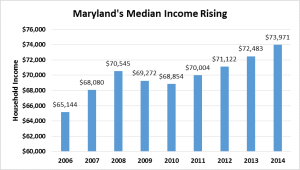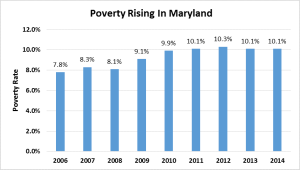More Marylanders Struggling to Make Ends Meet Despite Growth in Top Incomes
Although incomes have been on the rise for the past decade, many Marylanders are struggling and have not shared in the economic progress that the state’s wealthier residents have benefited from. State leaders must work to ensure that all Marylanders benefit from the growing economy, not just the wealthy few.
Since 2006, Maryland’s median household income (adjusted for inflation) has increased 13.5 percent, while the percentage of individuals struggling just to make ends meet and living below the poverty line has increased 29.5 percent. There are now 161,473 more Marylanders with incomes below the federal poverty line — $11,770 for a single person and $15,930 for a family of two — than nine years ago, according to the Census Bureau’s latest official data on poverty and income in Maryland, released today. This dichotomy of increasing average incomes while more people struggle to make ends meet indicates that most economic gains are going to wealthier residents and aren’t being shared widely among others.

More college graduates are not being paid enough to meet basic needs than at any other point in recent history, as they struggle with overwhelming amounts of student loan debt and limited job prospects. Over the past nine years, the total number of Maryland residents with a bachelor’s degree or higher who live in poverty has nearly doubled—increasing from 26,576 to 50,912. College graduates now account for nearly 10 percent of people in poverty.
The prospects for all of us in Maryland are poorer because of the fact that 1 in 10 of our neighbors are struggling just to afford housing, food, child care and transportation, up from almost 1 in 13 in 2006. Such a drastic increase in poverty is quite concerning, and to make matters worse, cuts made by the governor will likely continue this trend— making life harder for thousands and jeopardizing services that average and lower-income people rely on every day.
Less state support for higher education will result in graduates becoming more heavily burdened with college debt as universities are forced to raise tuition. These cuts made to education and other important services will make it harder for hard-working Marylanders to get ahead.
Despite the state’s falling unemployment rate, now down to 7.2 percent, and the fact that workers are more productive than at any other point in history, the low-wage jobs that have replaced high-paying positons still prohibit many Marylanders from pulling their families out of poverty.
It will become increasingly difficult for the state economy to thrive if only upper-income households are able to get ahead and be financially secure. That is why Governor Hogan and the General Assembly should invest in policies that increase opportunities for struggling people and help more families make ends meet so they can achieve a future of economic stability.

